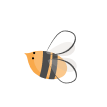- 3 days ago
Does Ear Infection in Children Increase During Summer?
What Is a Middle Ear Infection?
Otitis media occurs when fluid builds up in the space behind the eardrum, often becoming infected. It’s most common in:
- Children aged 6 months to 6 years
- Typically follows an upper respiratory infection
- Can also exist as otitis media with effusion (fluid without infection)
Can Middle Ear Infections Happen in Summer?
Yes. While more common in winter, several summer-specific factors increase the risk:
1. Swimming in Pools or the Sea
- Water trapped in the ear canal can lead to outer ear infections (otitis externa)
- If untreated, these can spread to the middle ear
2. Air Travel
- Changes in cabin pressure during flights can block the Eustachian tubes, leading to fluid buildup in the middle ear
3. Air Conditioning and Temperature Shifts
- Sudden temperature changes can cause nasal congestion and postnasal drip, affecting ear pressure and increasing infection risk
Symptoms of Summer Ear Infections in Children
|
Symptom |
Description |
|
Ear pain |
Especially worse at night; younger babies may be irritable or cry more |
|
Fever |
Usually mild to moderate (38–39°C / 100.4–102.2°F) |
|
Feeding difficulty |
Pain increases during sucking or swallowing |
|
Fluid drainage |
If eardrum ruptures, fluid may leak out |
|
Balance issues |
Older children may feel dizzy |
|
Hearing problems |
Temporary hearing loss due to fluid in the ear |
Diagnosis and Treatment
- Diagnosed via otoscopic exam by a pediatrician or ENT specialist
- Treatment depends on severity:
- Mild cases may resolve with pain relief and observation
- More severe cases may require antibiotics
- Chronic fluid buildup may require ear tube placement (ventilation tubes)
If there’s any fluid discharge, avoid water exposure and consult a doctor.
Tips to Prevent Summer Ear Infections
1. Prevent Water from Entering the Ears
- Use age-appropriate earplugs when swimming
- Gently dry ears after swimming, avoid inserting cotton swabs
2. Use Air Conditioning Wisely
- Keep the room at a stable 22–24°C (72–75°F)
- Avoid direct airflow to the child’s face
3. Protect Ears During Flights
- Let your child nurse, sip water, or chew gum during takeoff and landing to equalize pressure
4. Monitor Allergy and Postnasal Drip
- Summer allergies can increase mucus, affecting the Eustachian tube
- Treat nasal congestion early to reduce ear infection risk













